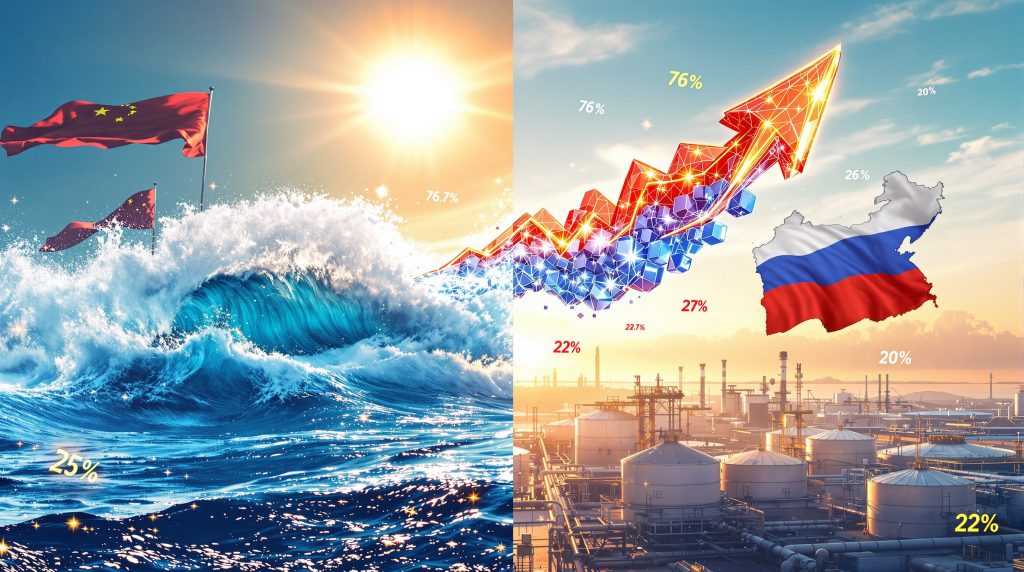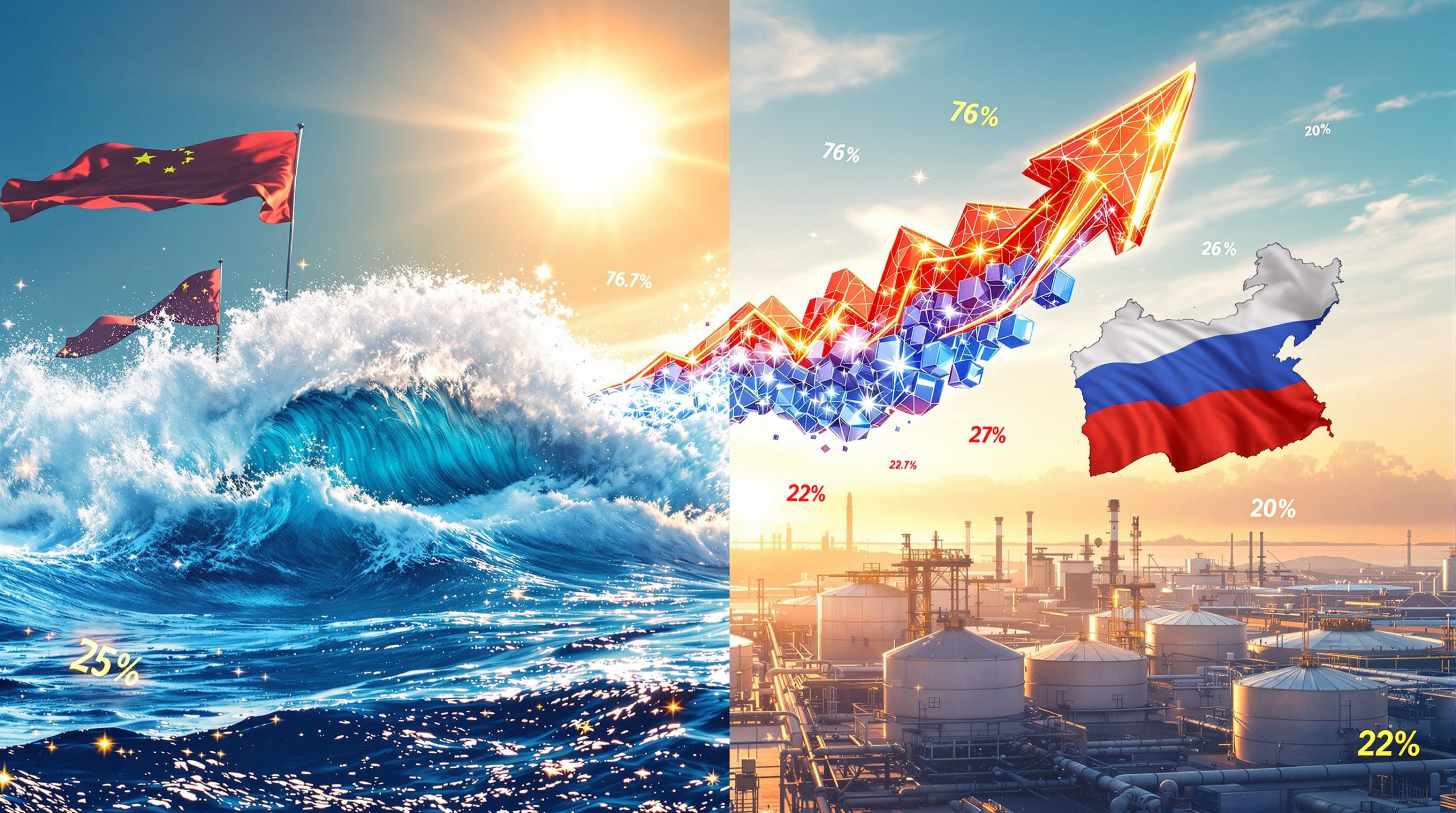The global energy landscape reveals profound structural transformations as traditional supplier-buyer relationships undergo fundamental realignment. Asian markets increasingly serve as alternative destinations for energy supplies previously bound for Western economies, creating new pricing mechanisms and trade corridors that challenge established commercial patterns. This shift reflects broader macroeconomic forces reshaping international commodity flows, where geopolitical tensions intersect with energy security imperatives to produce unprecedented market dynamics.
China buys Russian LNG at record-high levels, exemplifying these evolving patterns, particularly in liquefied natural gas markets where procurement decisions increasingly reflect both economic opportunity and strategic positioning. The convergence of Western sanctions, supply chain diversification priorities, and competitive pricing structures has created conditions favoring enhanced bilateral energy cooperation between major Asian economies and non-Western suppliers.
How Have Global Energy Trade Patterns Shifted Since Western Sanctions on Russia Began?
International energy flows demonstrate remarkable adaptability as traditional export destinations become restricted and alternative markets emerge to absorb redirected supplies. The European Union's comprehensive approach to Russian energy imports includes a phased LNG import ban, with short-term contracts terminating within six months and long-term agreements scheduled for cessation by 2027.
This regulatory framework has necessitated significant cargo redirection, particularly toward Asian buyers who maintain commercial flexibility and substantial import capacity. Chinese customs data released Thursday, November 20, 2025, revealed Russian LNG imports reached 1.3 million tonnes in October 2025, representing a dramatic 76.7 percent year-on-year increase and marking the first time monthly volumes exceeded the one million tonne threshold.
The magnitude of this shift becomes evident when examining portfolio composition changes. Russian LNG now represents 22.5 percent of China's total LNG imports, nearly doubling from 11.4 percent during the same period in 2024. Month-on-month growth patterns show sustained momentum, with October shipments rising 33.1 percent from September levels.
| Metric | October 2024 | October 2025 | Change |
|---|---|---|---|
| Import Volume | 736,000 tonnes | 1.3 million tonnes | +76.7% |
| Portfolio Share | 11.4% | 22.5% | +97% |
| Monthly Growth | N/A | 33.1% | Sequential |
These dramatic volume increases indicate successful cargo redirection from European markets toward Asian destinations, fundamentally altering global LNG flow patterns. Furthermore, price discovery mechanisms have adapted to accommodate this geographical shift, with Asian buyers capitalising on competitive pricing opportunities arising from restricted Western access.
The implications extend beyond bilateral trade relationships to encompass broader market liquidity considerations. Traditional European LNG buyers previously provided price competition and demand diversity for Russian exports. Their regulatory-mandated withdrawal concentrates Russian supply toward fewer destinations, potentially creating both pricing advantages for remaining buyers and supply security concerns for exporters.
What Are the Economic Drivers Behind China's Record-High Purchases of Russian LNG?
China's unprecedented Russian LNG procurement reflects multiple converging economic factors that extend beyond simple supply-demand dynamics. The 1.3 million tonnes imported in October 2025 represents not merely increased volume but a strategic response to favourable pricing conditions and supply chain optimisation opportunities.
Value dynamics reveal the pricing advantage driving increased purchases. While import volumes surged 76.7 percent year-on-year, the corresponding value increase totalled only 31.8 percent, indicating substantial unit price reductions. This pricing differential suggests Russian suppliers offer significant concessions to maintain market access amid Western sanctions.
Market analysts observe that Russia likely provides steep discounts to Chinese buyers on LNG shipments, while price declines prove less pronounced for non-Russian cargo sources.
The economic rationale encompasses several key elements:
• Cost Optimisation: Discounted Russian LNG reduces China's overall energy procurement costs
• Supply Diversification: Expanded Russian volumes decrease dependence on alternative suppliers
• Strategic Timing: Sanctions-induced pricing creates temporary arbitrage opportunities
• Payment Flexibility: Bilateral trade arrangements may accommodate alternative settlement mechanisms
• Long-term Positioning: Early market entry during supply redirection phases
China's strategic pivot toward alternative suppliers aligns with broader energy security objectives emphasising supply chain resilience and reduced exposure to Western-controlled energy networks. In addition, the government's facilitation of expanded Russian imports through state-owned enterprise procurement decisions demonstrates coordinated policy implementation.
Portfolio rebalancing effects become evident when examining the velocity of change. Russian LNG's share expansion from 11.4 percent to 22.5 percent within twelve months indicates deliberate commercial strategy rather than marginal supply adjustments. This acceleration suggests systematic procurement decisions reflecting both immediate economic advantages and longer-term strategic considerations.
The discount pricing mechanism operates through multiple channels, including modified payment terms, currency arrangements, and potentially reduced shipping costs. These factors collectively create attractive unit economics that justify expanded volume commitments despite geopolitical complications associated with sanctioned trade relationships.
How Do Shifting LNG Pricing Mechanisms and Steep Discounts Affect the Asia-Pacific Market?
Regional LNG markets demonstrate increasing price differentiation as sanctions-driven supply redirection creates distinct pricing tiers for Russian versus non-Russian cargoes. The mathematical relationship between China's volume growth (+76.7 percent) and value increase (+31.8 percent) for Russian imports suggests unit prices declined approximately 25-30 percent compared to previous year levels.
This pricing divergence affects multiple market participants and commercial relationships throughout the Asia-Pacific region. Traditional suppliers from Australia, Qatar, and the United States face competitive pressure as discounted Russian alternatives become more readily available to Asian buyers. Moreover, these natural gas price trends reflect broader market volatility.
Short-term Market Impacts:
• Chinese importers achieve reduced procurement costs and enhanced profit margins
• Competing LNG exporters experience pricing pressure on spot sales
• Regional price benchmarks reflect increased supply availability
• Contract renegotiation discussions incorporate new pricing references
Mid to Long-term Structural Changes:
• Asian buyers gain negotiating leverage with traditional suppliers
• Pricing benchmarks may incorporate Russian cargo availability
• Supply security considerations balance against cost optimisation
• Currency settlement mechanisms adapt to accommodate sanctions
The factors influencing discount magnitude include several technical and operational considerations:
- Payment Mechanisms: Alternative settlement systems avoiding Western financial networks
- Shipping Insurance: Modified coverage arrangements for sanctioned cargo transportation
- Currency Arrangements: Yuan-denominated transactions or barter trade structures
- Delivery Terms: Adjusted risk allocation between buyers and sellers
- Contract Duration: Shorter-term commitments reflecting regulatory uncertainty
Market psychology shifts as Asian buyers recognise sustained availability of competitively priced Russian LNG. This perception influences procurement strategy and long-term contract negotiations with all suppliers, potentially establishing new baseline expectations for pricing competitiveness. However, the US natural gas forecast indicates potential pricing pressures for North American suppliers.
The competitive response from traditional suppliers varies based on production costs and market positioning. Australian and Qatari exporters with lower production costs maintain greater flexibility to match pricing, while higher-cost US producers face margin compression pressures.
Regional trading dynamics adapt to accommodate increased Russian volume flows. Asian LNG hubs develop enhanced capabilities for cargo redirection, storage, and redistribution to optimise economic value from available supply diversity.
In What Ways Is China's Energy Security Strategy Evolving in Response to Global Realignments?
China's energy procurement patterns reflect a comprehensive strategy emphasising supply diversification, price stability, and reduced dependence on Western-controlled energy networks. The dramatic increase in Russian LNG purchases demonstrates practical implementation of these strategic priorities.
Supply chain resilience measures encompass multiple initiatives designed to enhance energy security through diversified sourcing. The expansion of Russian energy relationships provides an alternative to traditional suppliers from regions subject to Western political influence or regulatory oversight. Consequently, this approach aligns with broader energy transition challenges facing global economies.
Strategic Advantages for China:
• Price Stability: Discounted Russian supplies reduce overall procurement costs
• Supply Security: Multiple import corridors decrease single-supplier dependence
• Payment Flexibility: Alternative settlement mechanisms reduce dollar exposure
• Geopolitical Leverage: Enhanced bargaining position with Western suppliers
• Infrastructure Utilisation: Maximised capacity at existing LNG terminals
Government policy facilitates expanded Russian imports through several mechanisms. State-owned enterprises receive guidance prioritising energy security over purely commercial considerations. Regulatory frameworks accommodate alternative payment systems and modified shipping arrangements necessary for sanctioned trade.
The risk-opportunity analysis reveals several potential scenarios based on Western sanctions evolution:
| Scenario | Probability | China's Response Strategy |
|---|---|---|
| Sanctions Intensification | Medium | Accelerated Russian imports, alternative payment systems |
| Status Quo Maintenance | High | Gradual volume optimisation, portfolio balancing |
| Sanctions Reduction | Low | Strategic relationship maintenance, commercial terms normalisation |
Infrastructure considerations support expanded Russian LNG acceptance. China's substantial LNG receiving terminal capacity accommodates increased volumes without significant capital investment. Existing facilities in Jiangsu province and other coastal regions provide operational flexibility for cargo scheduling and inventory management.
Long-term energy planning incorporates Russian supply availability as a structural component rather than temporary opportunity. This perspective influences infrastructure investment decisions, contract negotiation strategies, and diplomatic relationship management priorities.
The strategic evolution encompasses broader energy transition considerations. While China pursues renewable energy development, natural gas serves as transitional fuel supporting economic growth during the decarbonisation process. Russian LNG provides cost-effective gas supply supporting this transition strategy.
What Geopolitical and Regulatory Dynamics Are Emerging from This Energy Realignment?
Bilateral energy cooperation between Russia and China demonstrates institutional deepening through enhanced commercial relationships and political coordination. The sustained growth in Russian LNG imports suggests systematic cooperation extending beyond opportunistic transactions.
Regulatory frameworks within China adapt to accommodate grey-market trade flows while maintaining compliance with domestic laws. Chinese customs authorities process increased Russian cargo volumes through established procedures, indicating government support for expanded trade relationships. These developments intersect with broader oil price movements affecting global commodity markets.
Key Regulatory Adaptations:
• Modified customs processing for alternative payment mechanisms
• Enhanced shipping documentation for sanctioned cargo sources
• Coordinated policy between energy ministries and trade authorities
• Streamlined approval processes for Russian energy contracts
Regional spillover effects influence neighbouring economies' energy procurement strategies. Other Asian nations observe China's successful Russian LNG integration and evaluate similar opportunities within their respective regulatory constraints. Furthermore, these dynamics create ripple effects throughout global energy markets.
The comparative analysis reveals different approaches among major Asian economies:
- India: Maintains Russian energy imports through alternative payment systems
- Japan: Adheres more strictly to Western sanctions frameworks
- South Korea: Balances commercial interests with alliance obligations
- Southeast Asian Nations: Evaluate individual risk-reward calculations
Energy analysts suggest the durability of discount-driven energy diplomacy depends on sustained Western sanctions and continued Russian production capacity availability.
Infrastructure interdependence develops through expanded trade relationships. Chinese LNG terminals optimise operations for Russian cargo handling, while Russian export facilities prioritise Asian market accessibility. This operational coordination creates mutual dependence extending beyond individual transactions.
Political assurances provide framework stability supporting commercial expansion. High-level diplomatic communication coordinates energy policy with broader bilateral relationships, ensuring trade continuation despite external pressures. Moreover, these developments influence broader oil rally under tariffs scenarios.
Reports indicate Russian suppliers offer significant discounts to maintain market access amid sanctions pressure. The emergence of alternative financial mechanisms supports sanctioned trade continuation. Currency arrangements, barter structures, and alternative settlement systems develop sophistication supporting expanded commerce volume.
How Might This LNG Trade Evolution Influence Broader Global Economic Trajectories?
Global energy market leadership patterns shift as traditional Western suppliers lose market share to sanctioned alternatives offering competitive pricing. This transition influences commodity market volatility, supply chain resilience, and regional economic integration patterns.
Energy inflation dynamics reflect regional variations in supplier access and pricing structures. Asian economies accessing discounted Russian LNG experience different inflation trajectories compared to European markets facing restricted supply and higher prices.
Supply chain reshuffling extends beyond bilateral relationships to encompass broader trading networks. European economies accelerating renewable energy transitions reduce long-term gas demand, while Asian markets absorb redirected supply volumes.
Hypothetical Scenario Analysis:
If European renewable energy acceleration reduces LNG import demand by 30-40 percent over five years, Asian markets would require substantial capacity expansion to absorb global supply volumes. This transition would fundamentally alter pricing mechanisms and supplier-buyer relationships worldwide.
Investment considerations for market participants include:
• Infrastructure Development: Asian LNG terminal expansion opportunities
• Shipping Assets: Specialised tanker requirements for alternative trade routes
• Technology Integration: Payment systems supporting sanctioned trade
• Risk Management: Currency hedging and political risk assessment
• Market Entry: Participation in evolving trade relationships
The decline of Western influence in Eurasian energy markets creates opportunities for alternative commercial structures. Regional trading arrangements develop independently of traditional Western financial systems and regulatory oversight. However, these developments create uncertainty regarding long-term market stability.
Commodity market volatility increases as established trading patterns adapt to new supplier-buyer relationships. Price discovery mechanisms incorporate geopolitical risk premiums and discount structures reflecting sanctions impact.
Long-term forecasting suggests continued energy market fragmentation along geopolitical lines. Western and non-Western energy networks may operate with limited integration, creating distinct pricing mechanisms and supply chain structures.
What Are the Quantitative Takeaways from China's Record-Breaking Russian LNG Imports?
The statistical foundation supporting this energy trade evolution demonstrates remarkable scale and acceleration. China buys Russian LNG at record-high levels, with quantifiable metrics supporting this unprecedented expansion.
Key Performance Indicators:
• Record Volume: 1.3 million tonnes imported in October 2025 (first monthly breach of 1 million tonne threshold)
• Growth Velocity: 76.7% year-on-year volume increase representing unprecedented expansion rate
• Market Penetration: Russian LNG capturing 22.5% of China's total imports (from 11.4% baseline)
• Sequential Momentum: 33.1% month-on-month shipment growth from September to October
• Value Differential: 31.8% year-on-year value increase indicating significant unit price reduction
| Metric | Absolute Value | Growth Rate | Market Implication |
|---|---|---|---|
| Monthly Volume | 1.3M tonnes | +76.7% YoY | Supply redirection success |
| Portfolio Share | 22.5% | +97% YoY | Strategic rebalancing |
| Value Growth | +31.8% | Volume differential | Pricing advantage |
| Sequential Growth | +33.1% MoM | Sustained momentum | Systematic expansion |
Summary Analysis: China buys Russian LNG at record-high levels in October 2025, establishing records across multiple metrics and demonstrating successful trade realignment as sanctions-induced discounting and cargo redirection create historic Eastern market expansion opportunities.
These quantitative indicators support broader conclusions regarding energy trade evolution, pricing mechanism adaptation, and geopolitical relationship development. The mathematical relationship between volume and value growth confirms substantial pricing concessions driving commercial expansion.
Market participants interpret these statistics as validation of sustained Russian supply availability and Chinese demand capacity. The data provides foundation for forecasting continued trade relationship development and regional market integration.
The record-breaking nature of these imports suggests systematic rather than opportunistic purchasing behaviour. Volume thresholds crossed and portfolio share expansion indicate strategic rather than tactical procurement decisions.
What factors drive steep discounts for Russian LNG?
Western sanctions restrict Russian LNG access to European markets, forcing suppliers to offer competitive pricing for alternative destinations. Payment mechanism complications, shipping insurance modifications, and reduced buyer competition contribute to discount structures. Currency arrangements and settlement alternatives may provide additional pricing flexibility.
How might sanctions escalation affect global LNG trade patterns?
Intensified sanctions could accelerate cargo redirection toward Asian markets, potentially increasing discount margins and volume availability. European renewable energy acceleration might reduce long-term demand, while Asian economies expand import capacity. Alternative payment systems and shipping arrangements would develop greater sophistication.
Will China maintain increased Russian LNG imports long-term?
Sustained imports depend on continued pricing advantages, supply chain reliability, and geopolitical relationship stability. China's energy security strategy emphasises diversification, suggesting Russian supplies will remain portfolio components. Infrastructure investments and contract commitments indicate long-term trade relationship development.
How does this realignment influence global energy prices?
Regional price differentiation increases as sanctioned and non-sanctioned supplies trade at different levels. Asian buyers gain negotiating leverage with traditional suppliers. European markets face restricted supply and higher prices, while Asian economies access competitively priced alternatives.
What alternatives exist for Western economies amid rising Asian demand?
Western economies can accelerate renewable energy transitions, develop alternative suppliers, and enhance energy efficiency measures. North American LNG production expansion and pipeline connectivity improvements provide supply alternatives. Strategic petroleum reserve management and demand response programmes offer short-term flexibility.
Disclaimer: This analysis incorporates market data, expert commentary, and forecasting elements that reflect current conditions and available information. Energy market dynamics, geopolitical relationships, and regulatory frameworks remain subject to rapid change. Investment decisions should incorporate comprehensive risk assessment and professional advisory consultation. Projected scenarios represent analytical possibilities rather than guaranteed outcomes.
Could Your Portfolio Benefit From the Next Major Discovery in Australia's Booming Energy Sector?
Discovery Alert's proprietary Discovery IQ model delivers real-time alerts on significant ASX mineral discoveries, including critical energy transition metals and resources driving today's global energy realignments. Subscribers receive instant notifications on breakthrough discoveries with the potential to reshape commodity markets, ensuring you stay ahead of transformational investment opportunities. Begin your 30-day free trial today to position yourself at the forefront of Australia's resource discovery boom.




